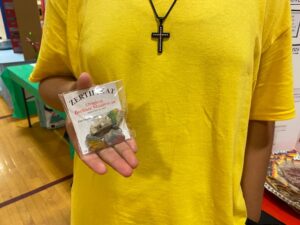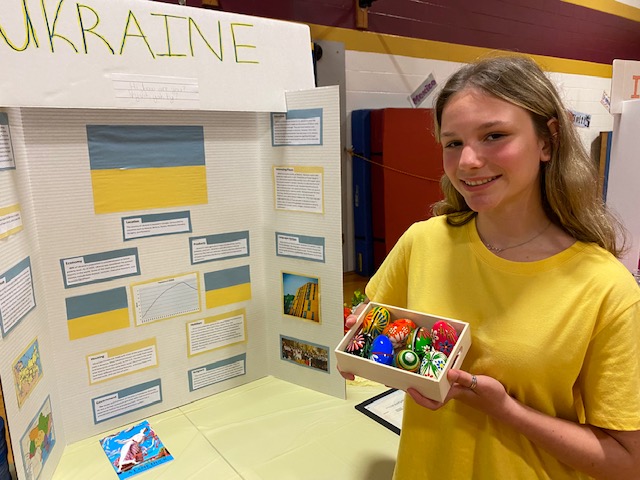VENTNOR - What do Peru, Dominican Republic, Germany, Ukraine, and the USA have in common? The answer is&engaged students who are eager to learn and share their cultural heritage.
Students at the Ventnor Educational Community Complex held their Multi-cultural Fair in the gym Thursday, June 2, sharing what they learned about different world cultures, including those of foreign countries where they, their parents or grandparents were born.
Organized by eighth grade history teacher Debbie Duff and seventh grade reading teacher Lori Henry, the fair featured science fair styled displays for different countries with flags, artifacts, and home cooked food from around the world. Eighth grade students were graded on their work, but for grades 5-7 participation was optional.
Due to the pandemic, the fair was not held since 2019. Unfortunately, parents were unable to attend this year due to a spike in new COVID-19 cases in the South Jersey area.
The kids were really anxious to participate and were asking us to please have it this year, Duff said.
Henry said the staff only learned the fair would be a go in March when Gov. Phil Murphy lifted the mask mandate for schools.
Duff said it was disappointing that parents could not attend, but they were supportive and sent in food for the students to share with their classmates
Eighth grader Viviana Arriago and her partner Lily Hocker chose to do their project on Peru.
My dad was born in Peru and my mom is Italian, Viviana said.
Wearing a Peruvian Soccer Team jersey, Viviana said her project represents her and her family's heritage.
I think everyone will be excited to learn about my culture, she said.
Viviana and Lily shared Paneton, a sweet bread with dried fruits that is traditionally served during the Christmas holiday, and Inca Cola.
In America and other countries, Coca Cola is everyone's favorite drink, but in Peru, it is Inca Cola. I think it tastes like bubble gum, Viviana said.
[rl_gallery id="26956"]
Sixth graders Hebert Lora and Bryanna Mena presented their project on the Dominican Republic, where Hebert was born.
We know a lot about our country and wanted to show the food we usually make, Bryanna said.
The duo served up orange rice with beans, and smashed plantains with cheese, salami, and onions.
It's called mangu and it's one of the things we eat most, Hebert said.
On the table were three books about famous baseball players from the Dominican Republic Manny Ramirez, Alex Rodriguez, and Albert Pujols, all good enough to be inducted into the Baseball Hall of Fame, Hebert said
They shared information about the Basilica Cathedral built in 1970 that beckons the faithful from around the world.
People come from all over come to pray there, Bryanna said.
And they had money too one bill was historic and no longer legal tender and other bills totaled $600 pesos, the equivalent of $6 in the USA, enough to buy two sandwiches, two juices and a basketball, they said.
I'm going back to visit in a month Hebert said. I can't wait to see my family and all my friends.
Alejandro Bautista, who will graduate from the VECC in a few weeks, selected Germany as his country.
Fewer people seem to pick Germany but my grandmother, Peggy, was born there, he said.
She helped him make veal sausage, called bratwurst, with little German flag toothpicks, and star cookies topped with cinnamon. He also served pretzels with Inglehoffer mustard imported from Germany.
During his project, he learned that Germany is 137,744 square miles, about the size of Montana or New Mexico, and that students there learn Latin and Greek as a second language.
The U.S. choses Spanish as its second language, he said.
 Also on display was a little plastic packet containing pieces of the Berlin Wall.
Also on display was a little plastic packet containing pieces of the Berlin Wall.
Victoria Klein-Mazar, also in the eighth grade, chose to do her project on Ukraine because of all the stuff that's going on there and because my dad's grandparents immigrated from the Village of Dorozhiv during World War II.
Victoria said she felt the need to support the beleaguered country.
It's good to represent them during hard times, she said.
Victoria displayed framed copies of her great grandparent's immigration papers, showing they came to the U.S. from Saskatchewan, Canada and wound up living in a small town in Pennsylvania. Because they lived in a seaside town in Ukraine, they got homesick for the beach and decided to move to Atlantic City.
 Victoria said she learned the country's main religion is Ukrainian Orthodox Christianity, and that the country is rich in natural resources such as iron ore and coal. The country grows wheat, barley, corn, and potatoes, so her culinary treat was potato pancakes. She also displayed a little box filled with hand-painted Ukrainian eggs.
Victoria said she learned the country's main religion is Ukrainian Orthodox Christianity, and that the country is rich in natural resources such as iron ore and coal. The country grows wheat, barley, corn, and potatoes, so her culinary treat was potato pancakes. She also displayed a little box filled with hand-painted Ukrainian eggs.
Also working in a team, Sofia Vitanza and Taylor Ebert, who will go on to high school next year, chose to do their project on the good ole' USA.
I'm very patriotic and I love my country, said Sofia, wearing a jersey with the 2nd Amendment on the back. Taylor wore a We the People T-shirt with the Pledge of Allegiance on the back. They both donned red, white, and blue cowboy hats.
The girls said their research taught them about the climate in various regions and the products made and exported to other countries.
I didn't realize that all these things are made in the USA, she said.
They also learned about the economy, which is not doing so well at this time, due to inflation, they said.
All the prices for gas and everyday things are going up, which is causing inflation, Sofia said.
Their All-American culinary offering was Rice Krispy treats, with red, white, and blue speckles, of course.
Copyright Mediawize, LLC 2021